On 6 June, 2023 the Russian occupiers carried out one of the largest terrorist attacks on the territory of Ukraine – they blew up the dam of the Kakhovka hydroelectric power station. Ukrainian officials estimate the explosion as an ecocide and war crime. Even now, more than a year after the tragedy, it is impossible to fully assess all the consequences of the disaster.
Nevertheless, it can already be stated that the destruction of the dam, which caused significant flooding of the territories, in addition to human casualties and material damage, caused humanitarian and man-made disaster, destroyed the landscape, changed ecosystems, polluted aquifers, and clogged coasts and waterways.
The Green Leaf NGO has created an interactive map that contains important information about the Kakhovka disaster and its aftermath, including official responses to the organisation’s inquiries. The map is intended for all researchers of this terrible terrorist act of Russia. It will be updated as new data becomes available.
Watch in full screen mode Copy link to map Submit data
Chronology of events
What preceded it:
- February 2022 – Russian invaders seized the Kakhovka HPP and the beginning of the North Crimean Canal.
- August 2022 – Despite the occupation, Kakhovka HPP continues to operate in the Ukrainian power grid. Four of the six units were in operation, i.e. 2/3 of the installed capacity. One of the units was undergoing reconstruction and another was undergoing major repairs.
- October 2022 – Ukrainian intelligence reports possible terrorist attacks on Kakhovka HPP: “The main mining works were carried out in April (2022 – ed.). During the current week (October 2022 – ed.), additional. The locks and supports of the Kakhovka hydroelectric power station were mined. Two military tented Kamaz trucks without drivers were installed at the dam. Both vehicles are fully loaded with boxes of explosives,” the DIU reported on 21 October, 2022.
- 11 November 2022 – Ukrainian defence forces liberated Kherson from Russian invaders. During the retreat the Russian military blew up the bridge of the Kakhovka hydroelectric power station.
- On 30 May, 2023 the Russian government adopted a resolution allowing not to investigate accidents at hazardous facilities that occurred as a result of hostilities, including terrorist attacks. “By 1 January 2028, technical investigations of accidents at hazardous production facilities and accidents of hydraulic structures that occurred as a result of military operations, sabotage and terrorist acts, shall not be carried out,” the document says. The resolution also contains clauses stating that until 1 September, 2023 and until 1 March, 2024, the following shall not be applied at the facilities in the “DPR”, “LPR”, Zaporizhzhia and Kherson regions part of the clauses of the Federal Law “On Industrial Safety of Hazardous Production Facilities” and “On the Safety of Hydraulic Structures”.
- On 6 June, at 2:35am and 2:54am, seismic sensors in Ukraine and Romania detected signs of powerful explosions. And US reconnaissance satellites equipped with infrared sensors recorded signs of heat consistent with a large explosion near the Kakhovka reservoir dam.
The course of events
6 June 2023:
- At 6am the organisation ‘Pivden‘ reported that the Russian occupiers had blown up the dam of the Kakhovka hydroelectric power station.
- at 06.45 – Oleksandr Prokudin, head of the Kherson Regional Military Administration, announced the evacuation due to the threat of flooding. Prokudin noted that water will reach a critical level in 5 hours.
- At 8 a.m. the Kherson City Council announced that the Korabel neighbourhood in Kherson was cut off due to the threat of flooding, and also reported that gas supply was cut off. At around 9 o’clock the area began to flood.
- the water level in the Kakhovka reservoir began to drop rapidly, by about 15 cm per hour.
At around 10 a.m. the Office of the Prosecutor General announced that a criminal case had been opened on the facts of ecocide and violations of the laws and customs of war. In the morning a zoo in Nova Kakhovka (territory occupied by Russian troops – ed.) was flooded “Fairy Tale Grove”, a summer theatre, a monument to Shevchenko, a coffee shop, a playground in the city, a boat station, and a yacht club. The mayor of Nova Kakhovka Volodymyr Kovalenko also reported about the approach of water to Dniprovskyi Avenue and the unstable operation of Internet in the city. In his opinion the Russians were “jamming communications” in order to leave the townspeople in an information vacuum.
7 June 2023:
a rise in water level of approximately 5 metres at the Kherson post since the accident. In Nikopol (above the destroyed dam), the water level has dropped to 2.2 metres. By according to Ukrhydroenergo’s preliminary forecast, water from the Kakhovka reservoir is expected to be fully released into the lower reaches of the Dnipro River by 12 June 2023. This is a volume of 18.2 km of water. “The Kakhovka reservoir will be emptied very quickly. This means a bare bottom with silt and the death of hundreds of plant and animal species. This will lead to a shortage of drinking water and drought throughout the south, which was supplied with water from Kakhovka hydroelectric power station. These are eroded cattle cemeteries, burial grounds, and ordinary burials that will end up in surface waters in the lower reaches of the Dnipro River,” said Ruslan Havryliuk, head of the National Ecological Centre of Ukraine.
- 1700 people were evacuated.
- 29 settlements were flooded, 19 of which were in the government-controlled area.
8 June 2023:
- the water level in the Kakhovka reservoir in the evening was 12.5 metres, which is below the so-called “dead point”, below which water intake is impossible, half of the station was under water, the other half by 70%. The earthen insert between the lock and the station was also under water and was being eroded.
- The average flood level is 5.61 metres. 600 km² of Kherson region are under water, of which 32% are right bank and 68% on the left bank.
- Tyahynka, Lvov, Odradokamyanka in Beryslav district, Ivanivka, Mykilske, Tokarivka, Poniativka, Bilozerka, and the Ostrov neighbourhood in Kherson are completely or partially flooded.
- The state managed to evacuate 2198 people. During the evacuation the Russian military shelled Kherson injuring 9 people.
9 June 2023:
The Kakhovka reservoir continued to shrink with a total water drop of 4.7 metres. As of the morning the reservoir level in the Nikopol area was 11.74 metres. Every second, about 40,000 cubic metres of water leaked out of the reservoir.
10 June 2023:
- the water level in the Nikopol area dropped to 10.42 metres, and in the cooling pond Zaporizhzhya NPP is 16.67 m, and this is enough to meet the needs of the plant, Energoatom assured.
11 June 2023:
- The level of the Kakhovka reservoir near Nikopol was 9.35 metres. The water level dropped by more than a metre overnight, and by more than 7 metres since the explosion.
- 2,678 people were evacuated from the territory of Kherson region.
Calculation of losses
A year after the tragedy the first deputy head of the State Ecological Inspectorate of Ukraine Dmytro Zaruba said that the Kakhovka dam had caused environmental damage.
According to preliminary estimates the damage is UAH 146 billion worth. However the full picture of the damage will only be seen after the de-occupation of southern Ukraine.
According to Oleksandr Krasnolutskyi, First Deputy Minister of Environmental Protection and Natural Resources of Ukraine, the areas on the left bank of the Dnipro River suffered the most damage – 60%. A significant part of them is now under occupation.
High water flooded 80 settlements, nearly 4,000 residents of the Kherson region were evacuated, and 32 people died.
About 300 animals were rescued and 507 thousand tonnes of water were pumped out.
However the data on casualties and deaths are inaccurate, as it is impossible to count the number of people who were injured and killed in the occupied territory, where the destruction was widespread, especially in Oleshky and Hola Prystan.
According to the Kyiv School of Economics (the experts’ analysis was conducted at the end of June 2023, less than a month after the tragedy), the amount of direct damage caused to Ukraine’s economy by the explosion of the Kakhovka HPP is at least $2 billion:
- The housing stock of settlements in Kherson and Mykolaiv regions suffered losses: 49 and 31 cities, villages and towns respectively.
- more than 500 private houses in rural areas were flooded in Mykolaiv region.
- In Kherson region, the exact total number of damaged or destroyed residential buildings cannot be determined due to the partial temporary occupation of the region. However preliminary estimates suggest that around 20-30 thousand homes have been affected by the flooding, including at least 150 multi-storey buildings in the city of Kherson.
- direct damage from the flooding of private homes and related infrastructure is estimated at $950 million, the bulk of which is on the left bank of the Dnipro River, which is currently under temporary occupation.
- analysis of satellite images and modelling revealed 32,000 homes at risk.
- In 2023 Ukraine will face additional costs for the construction of water pipelines. Due to the drop in the water level in the Kakhovka reservoir, a large part of Dnipro, Zaporizhzhia, Mykolaiv and Kherson regions were at risk of being left without water supply. To deal with the consequences of the destruction of the hydroelectric power station, the Budget Committee approved the allocation of $41 million (UAH 1.5 billion) for the construction of main water pipelines.
- More than a quarter of the total damages caused by the hydroelectric power plant explosion – $586 million – are directly related to the destruction of the 334.8 MW Kakhovka hydroelectric power plant, which cannot be restored, and the dam.
- total losses in the energy sector reached $624 million.
- The annual economic losses caused by the destruction of the hydroelectric power station to the state-owned Ukrhydroenergo amount to more than $100 million.
- The cost of building a new hydropower plant of similar capacity is about $1 billion.
- power grids in flooded settlements were lost, and 17 petrol stations and 2 oil depots were flooded.
- damage to transport infrastructure reached $311 million.
- According to project experts, more than 290 km of roads were affected by the floods. Some international and regional roads are flooded. Municipal roads are the most damaged – more than 50% of the total length.
- According to preliminary estimates, industrial enterprises and other businesses have already lost $105 million as a result of the blast.
- The destruction of crops, livestock and fish resulted in $25 million in losses to agriculture.
- The Kakhovka Reservoir was used to provide water for irrigation systems and livestock farming on a total area of 584,000 hectares (the actual area of irrigated land before the war was 262,000 hectares). Therefore, indirect income losses for crop production will increase by $182 million a year. Other industries in the sector will lose up to $49 million a year.
- The estimated amount of damage to the environment is estimated at $1.5 billion (according to the Ministry of Environmental Protection and Natural Resources). 150 tonnes of oil leaked during the dam explosion. The salinity level of the Black Sea near Odesa is almost three times lower than normal.
- Flooding threatens three nature reserves: “Nizhnedniprovsky, “Kamianska Sich”, “Sviatoslav’s White Coast”, and the Black Sea Biosphere Reserve, which is protected by UNESCO. In addition, the Kinburn Spit Regional Landscape Park with a total area of almost 18,000 hectares; the Volyzhyn Forest, Dovgy, and Krugly Islands of the Black Sea Biosphere Reserve with an area of 2,700 hectares; and the Vysunsko-Ingulets Regional Landscape Park with an area of 2,700 hectares were also affected.
- In 2023 the Ministry of Reintegration paid UAH 200 million to those affected by the consequences of the Kakhovka hydroelectric power station explosion. However, this amount is not final, as a large number of houses and apartments are located in the shelling zone, so many homeowners have not received payments. This also does not include residents of the currently occupied territories of the left-bank Kherson region. According to the First Deputy Minister of Environmental Protection and Natural Resources the most damaged territories were those of Ukraine’s resources, according to Oleksandr Krasnolutskyi, located on the left bank of the Dnipro River – 60%. Now a significant part of them is under occupation.
- The Territorial Development Department of the Kherson Regional State Administration paid UAH 36.5 million for the construction of four artesian wells to provide water supply to the Novooleksandrivska territorial community.
Budgetary funds for remediation
In 2024 the infrastructure restoration and development services in Mykolaiv and a number of procurements were made in Dnipropetrovska oblast to address the negative effects caused by the destruction of the Kakhovka HPP.
So far 19 procurements have been made. But the number is likely to grow. Among them is the construction of new water pipelines Marhanets-Nikopol-Pokrov, “Khortytsia-Tomakivka-Marhanets and Ingulets-Pivdenne Reservoir, the need for the construction of the new reservoir will be carried out in the wake of the destruction of the Kakhovka HPP. The total cost of the construction of the new Ingulets-Pivdenne Reservoir water pipeline, which will supply water to Kryvyi Rih, is almost UAH 7.7 billion. New water pipeline construction “The Khortytsia-Tomakivka-Marhanets pipeline is worth UAH 7.3 billion. And the water supply system “Marganets-Nikopol-Pokrov will cost taxpayers 2.6 billion. It is noteworthy that the cost may rise further in the course of the work.
In addition, due to the destruction of the Kakhovka HPP, a new water supply system is also planned to be built in Mykolaiv Oblast. Consultations are currently underway. These works are also likely to cost billions of hryvnias.
Who is to blame
Immediately after the disaster the Russian side shifted the responsibility to Ukraine. Ukrainian troops allegedly sabotaged the Kakhovka hydroelectric power station. According to Russian Presidential Spokesperson Dmitry Peskov, by blowing up the hydroelectric power station, the ‘Kyiv regime’ planned to deprive Crimea of water. The upper part of the Kakhovka hydroelectric power station was allegedly destroyed as a result of shelling by the Ukrainian armed forces.
However the Russian side has not provided any evidence beyond words. Moreover, on 5 April, 2024, almost 10 months after the explosion, it was Russian Telegram channels that first published a video of the destruction of the Kakhovka hydroelectric power station in the first minutes after the explosion.
At the same time, Ukraine blames the Russian military for the explosion of the Kakhovka hydroelectric power station, given that it was they who controlled the hydroelectric facility.
Then NSDC Secretary Oleksiy Danilov said that the terrorist attack was carried out by 205th motorised rifle brigade of the Russian Federation, which controlled the station. According to Danilov, the dam was blown up with explosives, and the Russian invaders simply could not have calculated the consequences of such actions, because “water is the most destructive force on the planet”.
It is likely that the dam was directly blown up by the first battalion of the 205th motorised rifle “Cossack” brigade of the Russian army from the city of Budyonovsk, Stavropol Territory. In response to the request of the Green Leaf NGO, the Office of the Prosecutor General informed that since 6 June 2023, law enforcement officers have been investigating criminal proceedings into the undermining of the main structure of the Kakhovka HPP by Russian military personnel.
On 6 June 2024, it became known that a Russian general had been notified of being suspected of this crime. It is likely to be Oleg Makarevich, who is suspected under Part 2 of Article 28, Part 2 of Article 438 of the Criminal Code of Ukraine (violation of the laws and customs of war, combined with premeditated murder, committed by prior conspiracy). The Security Service of Ukraine notes that this Russian military commander of the 205th Engineer Service a separate motorised rifle brigade was ordered to blow up the dam of the Kakhovka hydroelectric power station.
The general description of the 205th Brigade of the Russian Federation was provided by journalists of the Defence Express. According to them, the brigade has been fighting in Ukraine since August 2014. At that time, the following were involved in the fighting contract soldiers who were supposedly on training, but in reality were fighting in Ukraine near Avdiivka and Makiivka.
Before the full-scale invasion in the autumn of 2021, the Russian army used the 205th Brigade as one of the points for the deployment of the BARS mobilisation programme – the “Combat Army Reserve”. As conceived by the Russian Ministry of Defense, if necessary, this programme is able to provide a flow of volunteers who have already signed a contract. Obviously, Russia’s “Ministry of Attack” knew for sure that in the near future they would need a lot of new “meat” for the war.
Since February 2022, units of the 205th Brigade have been directly involved in Russia’s full- scale invasion of Ukraine. It is known that the brigade’s soldiers captured southern Ukraine.
At the same time, in August 2022, a “board of shame” appeared in this brigade with a list of “refuseniks”. In the autumn of 22nd, the brigade fought unsuccessfully against the Ukrainian armed forces in the area of Snihurivka, Mykolaiv region. And in November, it retreated with other units of the Russian army from the Kherson direction, continuing the occupation of the left bank of the Kherson region.
After the Kakhovka hydroelectric power station was blown up, the so-called Russian military commanders repeatedly reported on the miserable situation of the 205th Brigade on the left bank of the Dnipro River – as if the occupiers were surrounded. In December 2023, an expert from the Information Resistance group, Oleksandr Kovalenko, reported that the brigade was being withdrawn from the Kherson region to recovery. This may indicate significant losses among the occupiers and the inability to perform combat missions.
After the terrorist attack, journalists of the “Schemes” programme and the Slidstvo.info agency were able to Identify a number of soldiers of the 205th motorised rifle brigade of the Russian Federation, which is likely to be involved in the explosion of the Kakhovka hydroelectric power station.
According to investigators, since August 2022, the brigade has been led by 43-year-old Colonel Roman Titov from the Altai Territory. According to Ukrainian intelligence, Titov has been directly involved in criminal activity in Ukraine since 2015. Roman Titov has a criminal record for abuse of power with the use of violence and weapons. In addition to Titov, journalists were able to identify several other Russian soldiers from the 205th Brigade. Namely, Arsen Pitskhelauri, who was awarded after the destruction of the dam Kakhovka HPP, as well as sapper Ruslan Magomedov and Major Denis Mishchenko.
Environmental damage
After the Kakhovka hydroelectric dam was blown up, experts from the State Environmental Inspectorate were involved in assessing the situation.
The State Environmental Inspectorate of the Southern District (Kherson and Zaporizhzhia regions) reported that environmental inspectors were involved in of criminal proceedings No. 22023230000000307 dated 06.06.2023 as specialists for sampling of surface water in the Dnipro and Ingulets rivers, conducting instrumental and laboratory control, and establishing the amount of damage caused. All collected materials were handed over to law enforcement agencies for inclusion in criminal proceedings.
The State Ecological Inspectorate of the South-Western District (Odesa and Mykolaiv regions) reported on the work that has already been done by specialists after the explosion of the Kakhovka HPP. Thus, pursuant to the order of the head of the emergency response of a man-made regional nature related to the undermining of the Kakhovka reservoir dam by the Russian Federation dated 16.06.2023 No. 7, on 22 June 2023, a commission held a survey of the natural reserve fund of Mykolaiv region, which was in the flood zone, namely the Ivan-Kepine botanical reserve.
The reserve is located in the Bashtanka district (former Snihuriv district) of Mykolaiv region, within Pavlivka village council, on the slope of the left bank of the Ingulets river, south of the village of Ivano-Kepine. During the survey, it was found that as a result of an emergency situation related to the undermining of the Kakhovka hydroelectric power station dam by the Russian Federation, the water level in the Ingulets River increased, and, as a result, part of the Ivano-Kepine reserve was flooded. Damage was discovered and destruction of flora and fauna, including those listed in the Red Book of Ukraine, and certain areas with organic residues of destruction, waste transfer, and contamination with cattle waste products.
During the inspection of the reserve’s territory, numerous household waste sites (glass bottles, plastic bags) were found. Soil samples were taken in areas of possible land contamination. The remains of animals (fish, river crayfish, hare). Flooding results in soaking of the vegetation cover, leaching of the root system, and deposition of washed away materials.
The Ivanovo-Kepine Botanical Reserve plays an important role in preserving the population of the Chamaecytisus graniticus, a species from the Red Book of Ukraine, which is also listed in the Red List of the International Union for Conservation of Nature and the European Red List. It is endemic to the North-Western Black Sea region. In the reserve, this species grows on outcrops, some of which were temporarily flooded, and the roots of the plants were washed away.
During the survey of the reserve’s territory, it was recorded that the configuration of the crystalline outcrops, including bird and insect burrows. On the territory of the reserve, the burrows are home to the endangered bird species (Coracias garrulus), which is listed in the Red Book of Ukraine. As a result of the flooding, the burrows of the Coracias garrulus were damaged.
Based on the results, the damage caused to the territories and objects of the nature reserve fund as a result of a regional man-made emergency related to the undermining of the Kakhovka hydroelectric power station dam by the Russian Federation was calculated in accordance with the requirements of the Methodology for Determining Damage and Losses, caused to the territories and objects of the nature reserve fund as a result of the armed aggression of the Russian Federation, approved by the order of the Ministry of Environmental Protection and Natural Resources of Ukraine No. 424 of 13 October 2022.
The total amount of damage caused to the Ivano-Kepyne Botanical Reserve as a result of the armed aggression of the Russian Federation, namely the emergency situation associated with the undermining of the Kakhovka Reservoir dam by the Russian Federation, is UAH 489,837,288.12.
The inspectors also took soil samples in places that were flooded in as a result of the Kakhovka hydroelectric power station dam blowing up. In 2023 17 soil samples were collected (including 16 on agricultural land and 1 sample within the protected area), which revealed an excess of ammonium (exchangeable) in terms of ammonium nitrogen, nitrates in terms of nitrates, phosphorus (mobile forms), phosphorus pentoxide, chlorides, etc.
The calculated amount of damage for land contamination is UAH 1,230,382,537.5, including UAH 638,745,745 of agricultural land.
For the period from 06 June, 2023 to 31 December, 2023, the specialists of the Instrumentation and Laboratory Department of the Mykolaiv Oblast Control conducted continuous monitoring of the surface water status within the Mykolaiv Oblast. During this period more than 150 surface water samples were taken in five water bodies (Dnipro – Bug estuary, Bug estuary, Ingulets river, the river Pivdennyi Buh, Ingul River) and measurements were made for 12 indicators. The total number of pollutant measurements was more than 1800. There was also detected exceedance of COD, BOD5, chlorides, ammonia, nitrites, iron, phosphates.
After the destruction of the Kakhovka HPP, the Instrumentation and Laboratory Control Department In Odesa Oblast, 87 samples of Black Sea surface water were analysed and about 891 chemical parameters were determined. Samples were analysed for 11 indicators according to the scope of the laboratory’s authorisation to perform measurements at 5 sampling sites (Berth # 243, Nova Dofinivka village, Luzanivka beach, Otrada beach, 16th station beach of Velykyi Fontan, Langeron beach).
According to the measurements of the composition and properties of water samples carried out in the period from 06 June, 2023 to 20 June, 2023, the following exceedances of the standardised MPC values were detected of the following indicators: salinity (below the MPC, i.e. desalination of seawater), suspended solids, BOD5, total iron, oil products, ammonium nitrogen.
After 26 June, 2023 no exceedances of chemical parameters were recorded in water samples. At present the composition and properties of the Black Sea surface water have stabilised and meet the standardised MPC values.
How the Kakhovka disaster affected the state of the Black Sea
After the dam was destroyed water from the Kakhovka reservoir began to move rapidly towards the Black Sea. In a few hours it was already in the Dnipro-Bug estuary, a day later – in the Black Sea, two days later – off the coast of Odesa, and a week later it reached the banks of the Danube. A powerful wave of water brought household appliances, parts of destroyed houses, dead and even live animals – not only domestic but also wild ones, pieces of land torn off the land with reeds and even trees – to the coast of Odesa region.
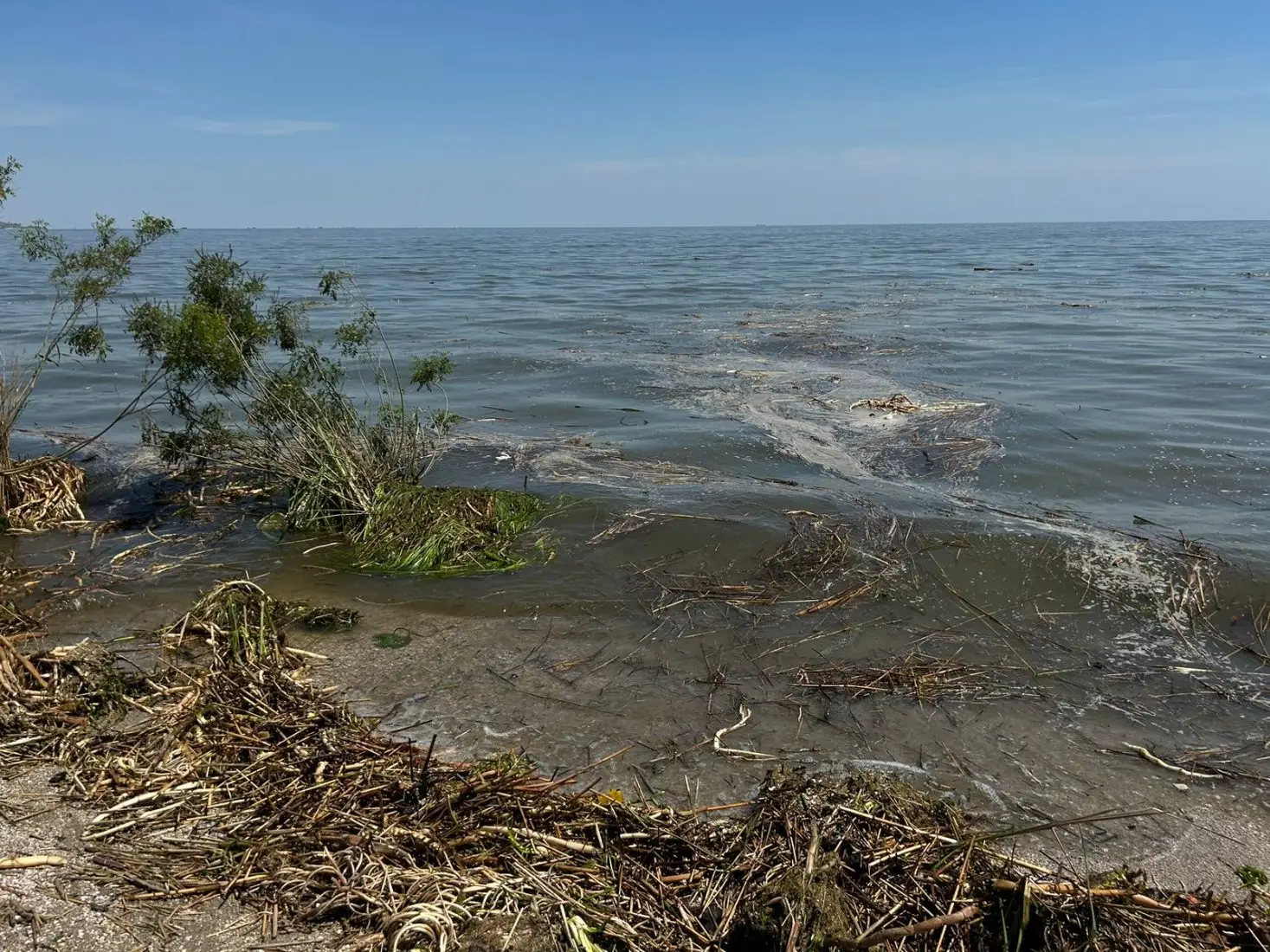
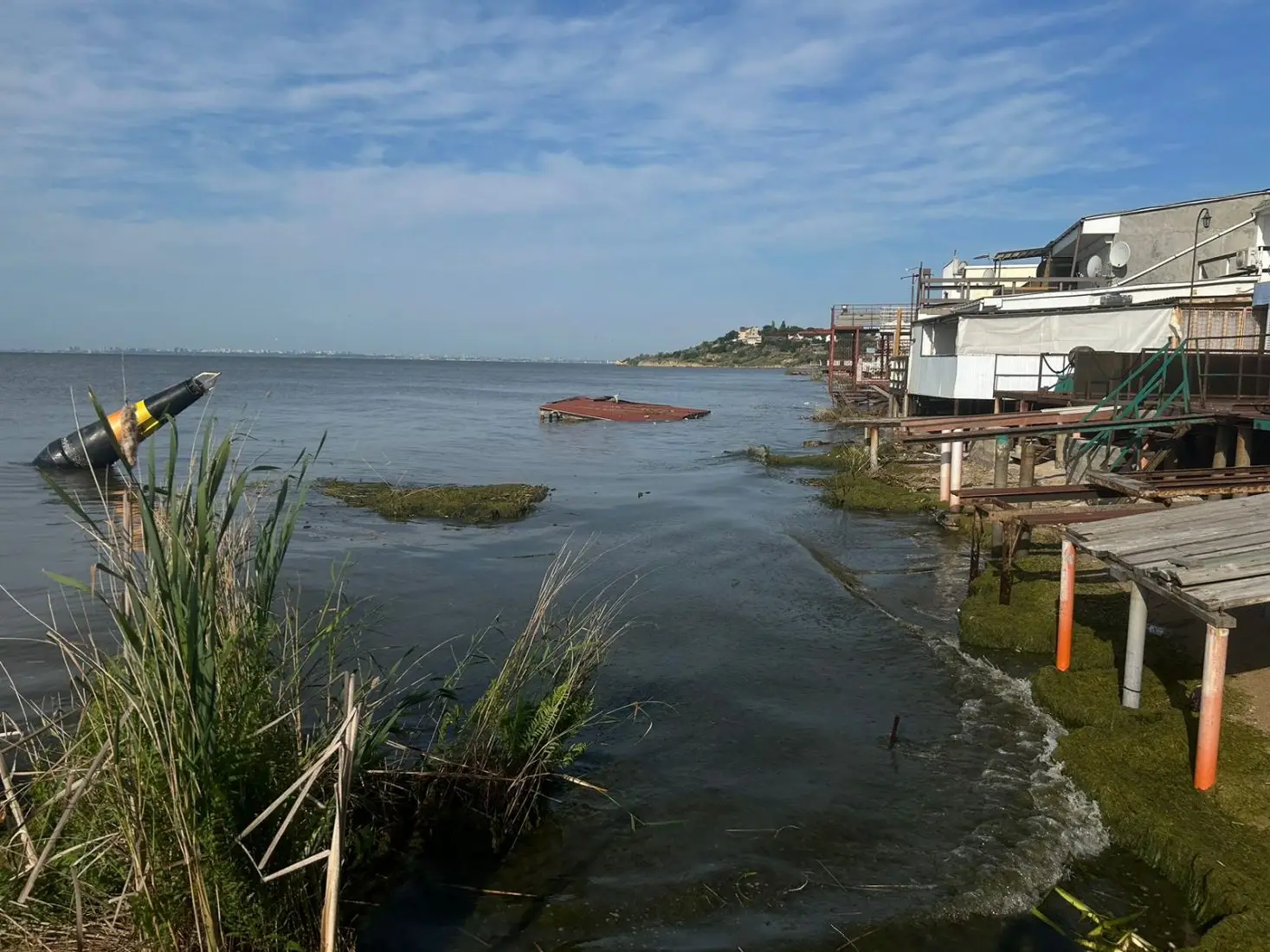
Photo by the State Ecological Inspectorate of the South-Western District of Ukraine
Satellite images clearly show that the plume of dirty water, which includes silt, raised from the bottom of the reservoir, fertile soil from flooded areas and the remains of washed away settlements, combines with the sea currents of the north-western part of the Black Sea and heads south to the coast of Romania and Bulgaria.
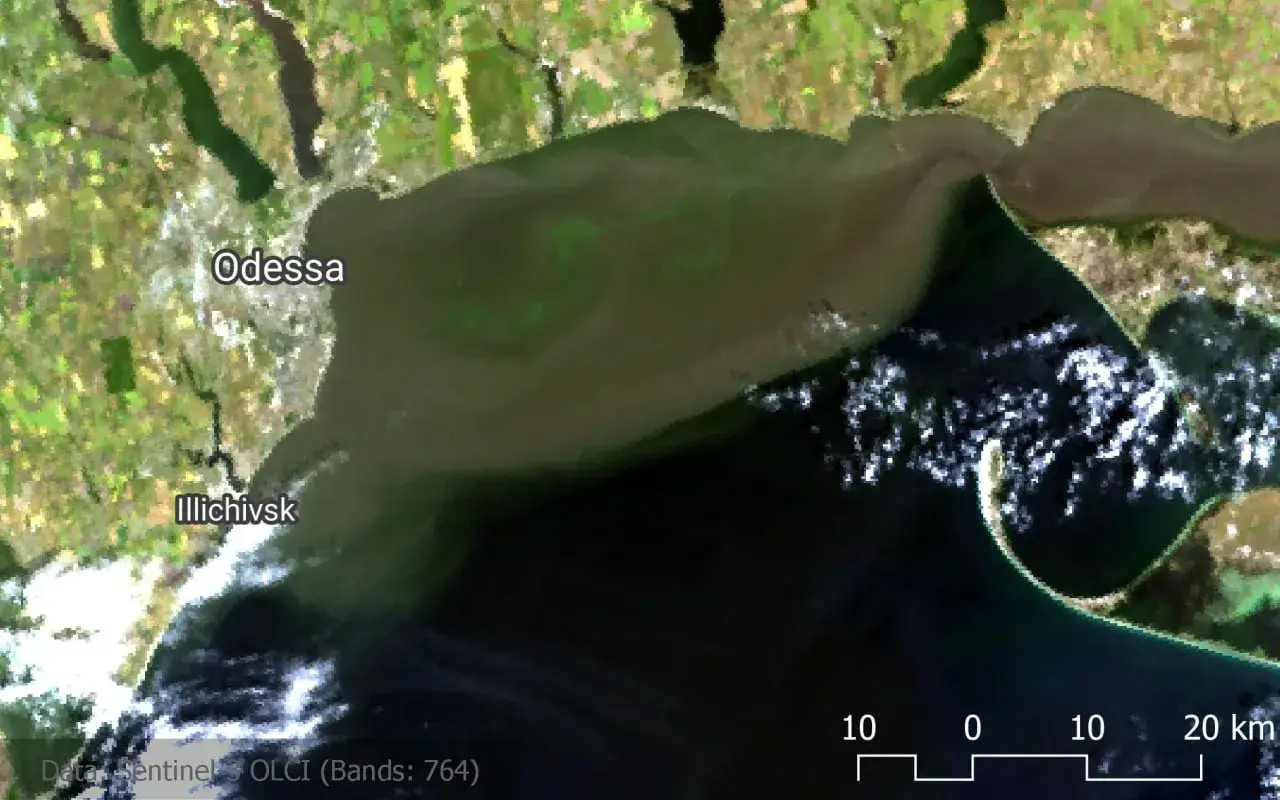
Sentinel-3 OLCI image taken on 2023-06-10 11:26 Kyiv time. Photo: Ukrainian Nature Conservation Group
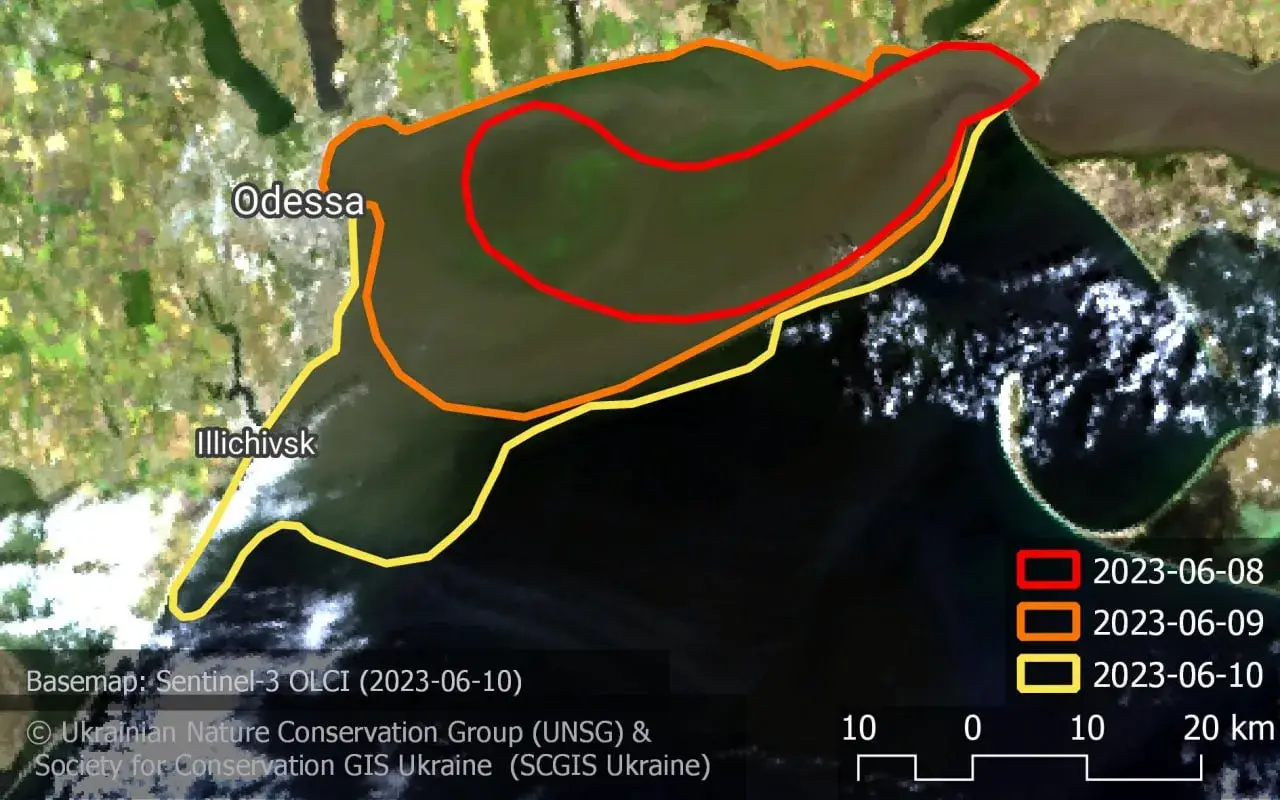
On 6 June, the area of sea siltation was 616.8 km², on 9 June – 1248.2 km², and on 10 June – 1710 km². Photo by the Ukrainian Nature Conservation Group.
The Kakhovka wave brought with it two powerful negative consequences for the marine ecosystem – not only pollution, but also desalination of seawater.
According to laboratory tests conducted by the State Environmental Inspectorate of the South-Western District of Ukraine, which took seawater samples at three different locations in and around Odesa, as of 10 July 2023, the salinity of the sea water had dropped by almost three times the normal level. Fresh water from the Kakhovka Reservoir entered the Black Sea 3-4 days after the dam breach and reached the coast of Odesa, reducing the normal salinity of sea water from the usual 17-18 ppm to 4 ppm.
The Ukrainian Scientific Centre for Marine Ecology (UkrSCME) reported that, according to satellite data, during the first week after the dam’s destruction, polluted river water covered more than 7,300 square kilometres of the north-western shelf of the Black Sea.
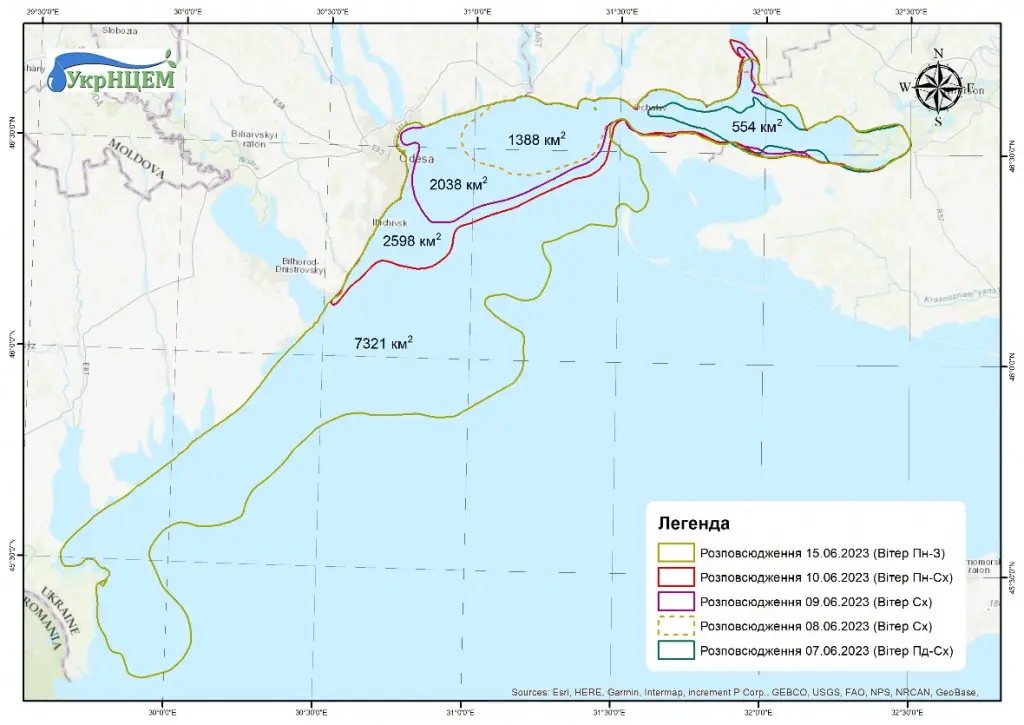
‘The water from the Kakhovka Reservoir did not just flow over the surface, it displaced sea water,’ said Viktor Komorin, Acting Director of UkrSCEM, at the roundtable discussion “The Impact of Military Operations on the Marine Ecosystems of Ukraine” held on 30 May 2024.
A scientific and organisational headquarters was immediately set up at the Institute of Marine Biology of the National Academy of Sciences of Ukraine (IMB) to assess possible threats to the Black Sea marine ecosystem as a result of the Kakhovka disaster. To record the dynamics of the environmental disaster the IMB conducted intensive monitoring of the marine ecosystem.
Since 6 June the IMB staff had been conducting expeditionary work in different parts of Odesa Oblast (Lanzheron, Malyi Fontan, Fontanka village, border with Mykolaiv Oblast). On 11 June, 2023 an ultra-high concentration of ammonium nitrogen was recorded in desalinated sea waters – 2 maximum permissible concentrations (MPC). Similar concentrations of ammonium nitrogen were observed in the area of Koblevo village (Mykolaiv region). This increase in ammonium nitrogen concentration may be due to direct pollution from sewage flushing as a result of flooding of collectors, cesspools, etc. on the path of water flow from the Kakhovka Reservoir.
On 11 June alarming information appeared on the IMB website: ‘Acute toxicity of water was observed in a sample from Langeron beach’.
On 13 June in another report , based on the analysis of satellite images, the IBM staff recorded an excess of ten times of the usual level of deviations of various indicators associated with the penetration of organic matter into the sea (turbidity, chlorophyll A content, and the content of suspended solids in the water). ‘This carries the risk of increasing the trophicity of the aquatic ecosystem, the development of microorganisms, microalgae blooms, and a general deterioration in conditions for biological communities,’ the experts concluded.
On the same day, Galina Terenko, an employee of the Ukrainian Scientific Centre for Marine Ecology, reported that the Gulf of Odesa had been ‘blooming’ with a complex of potentially toxic cyanobacteria. The ‘company’ of massive bunches of Aphanizomenon flos-aquae was made up of colonies of Dolichospermum flos-aquae and cyanobacteria Microcystis aeruginosa, at a sea water salinity of 5.1 ppm and a temperature of 19 degrees.
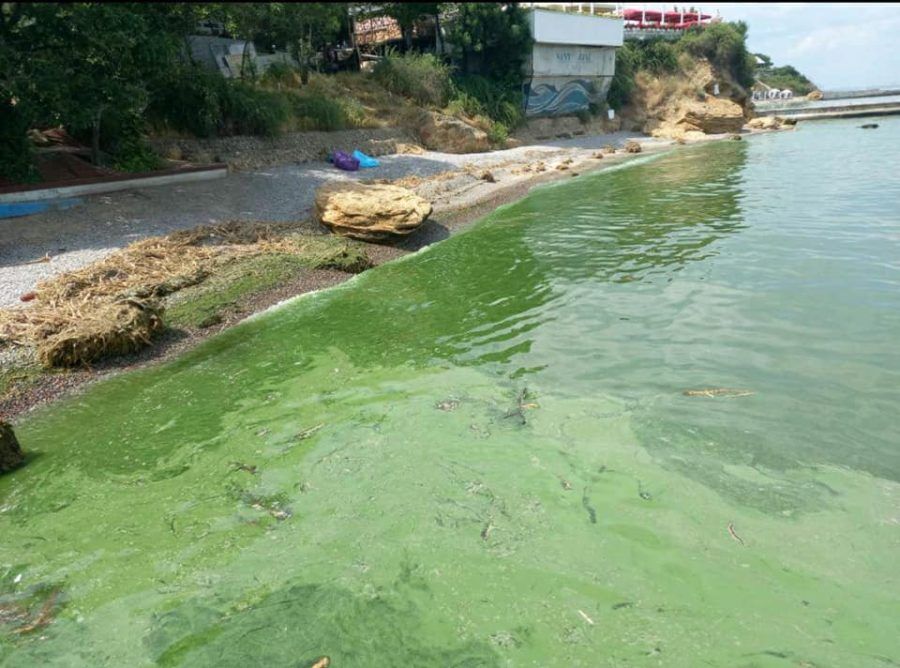
Photo from Halyna Terenko’s Facebook page
Vladyslav Balinsky, the head of the Green Leaf NGO, also recorded the active process of ‘sea bloom’.
On 22 June Balinsky observed a ‘red tide’ off the coast of Odesa. This happens when toxic algae, dinoflagellates, develop rapidly in sea water. This is one of the consequences of the explosion of the Kakhovka hydroelectric power station dam, which released hundreds of thousands of tonnes of dirty water into the Black Sea.
Due to the significant deterioration of the water in the sea and the real danger to public health, the Commission on Technogenic and Environmental Safety and Emergency Situations of the Executive Committee of the Odesa City Council banned swimming on Odesa beaches on 17 June and recommended refraining from eating fish and seafood of unknown origin. Based on the results of laboratory tests (virological, microbiological, parasitic) of water samples, the laboratories of the Odesa Regional Centre for Disease Control and Prevention of the Ministry of Health of Ukraine identified infectious agents, In particular, Salmonella enteritidis and Tifimurium, rotaviruses and astraviruses, cholera-like NAG vibrios, cholera-like vibrios Alginolithicus, parahaemolyticus, eggs and larvae of helminths of both humans and animals (pinworms, roundworms, dog roundworms, cryptosporidium oocysts). In addition, the LPC index (lactose-positive E. coli) significantly exceeded the regulatory requirements. The presence of all of these biological pathogens in the water of open water bodies in Odesa Oblast, including the Black Sea, the Bilhorod-Dnistrovskyi Estuary and the Danube River, posed a real threat to the life and health of the population.
In turn the IMB concludes based on the analysis of satellite images: ‘Almost half of the area of the southwestern part of the Black Sea (45.8%) as of 15.06.2023 is covered by the consequences of the Kakhovka Reservoir water entering the sea. Algal blooms are observed over an area of about 1500 square kilometres. Heavily contaminated areas (oil products, organic matter) cover about 6,000 square kilometres.’
Impact on wildlife
Three days after the 9 June disaster, a mass of fresh water with hundreds of so-called ‘quicksand’ – clusters of reeds clinging to their roots – was moving rapidly towards the Gulf of Odesa near the village of Fontanka. Along with the quicksand, various organisms washed up on the shore, including frogs, crustaceans, freshwater fish and terrestrial mollusks and insects that had largely died in the sea water.
In particular, Odesa residents rescued newts on their beaches and placed them in the Odesa Zoo. 55 newts were rescued by employees of the Tuzly Estuaries National Park and taken to the Danube Biosphere Reserve, where they were released in different parts of the river.
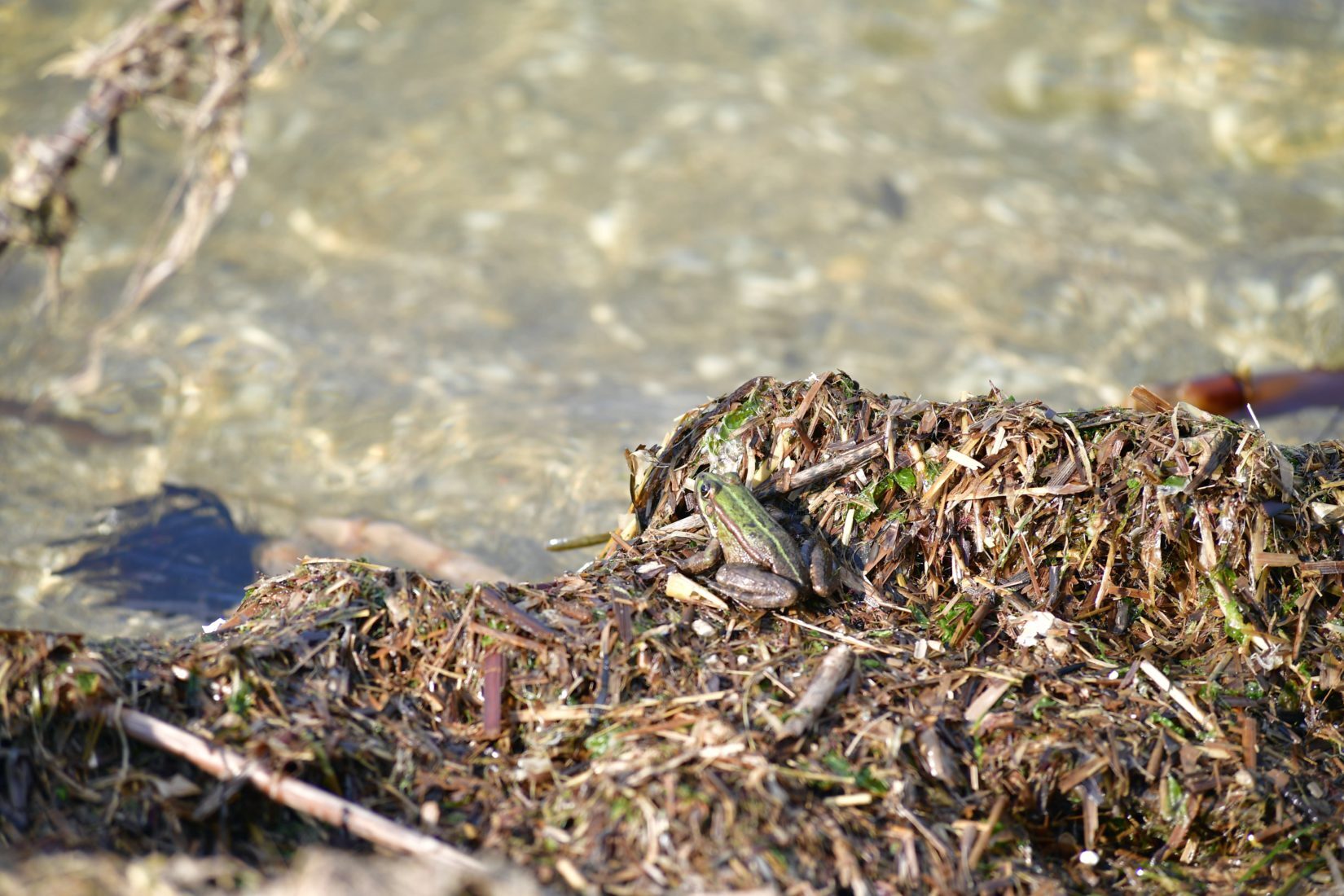
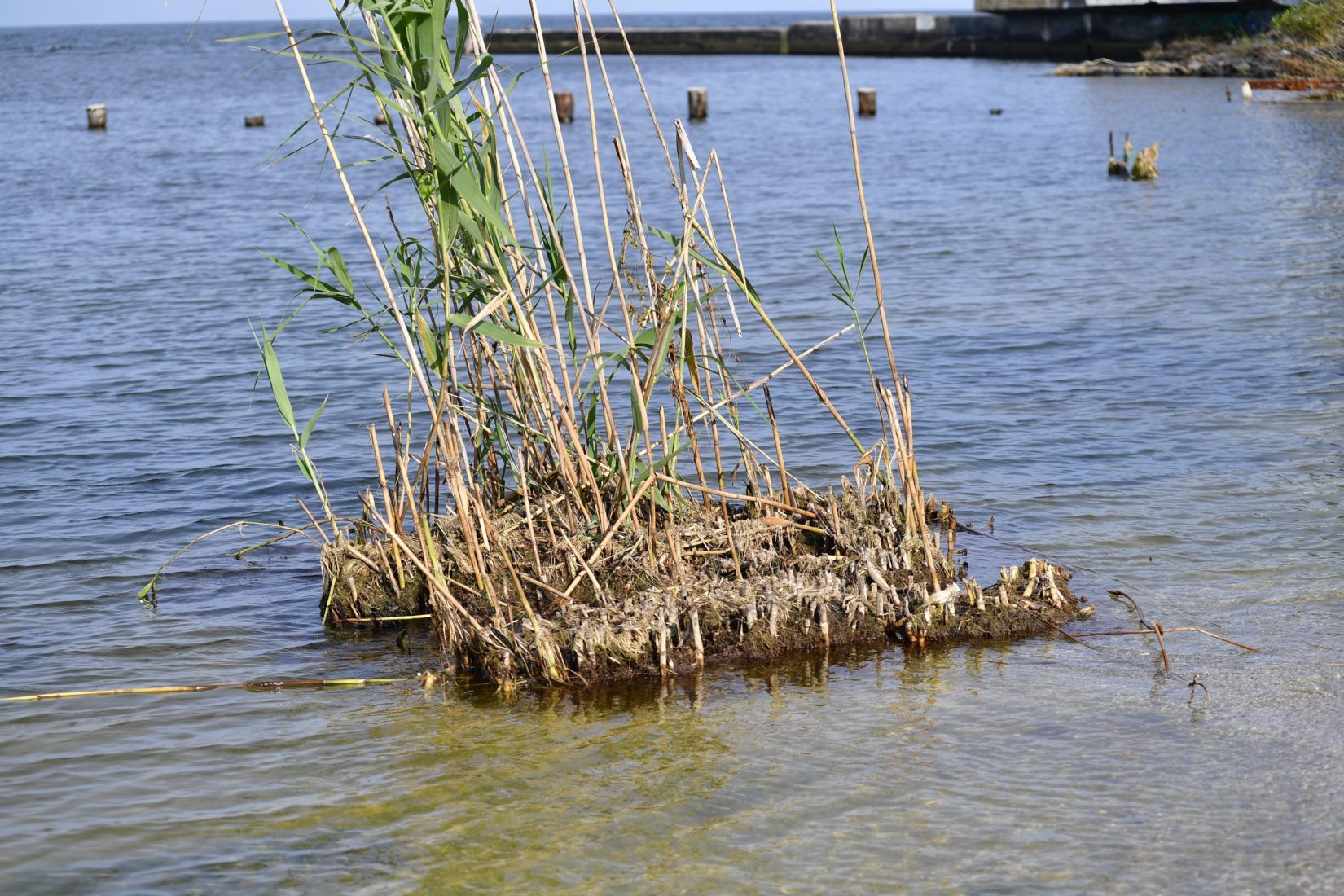
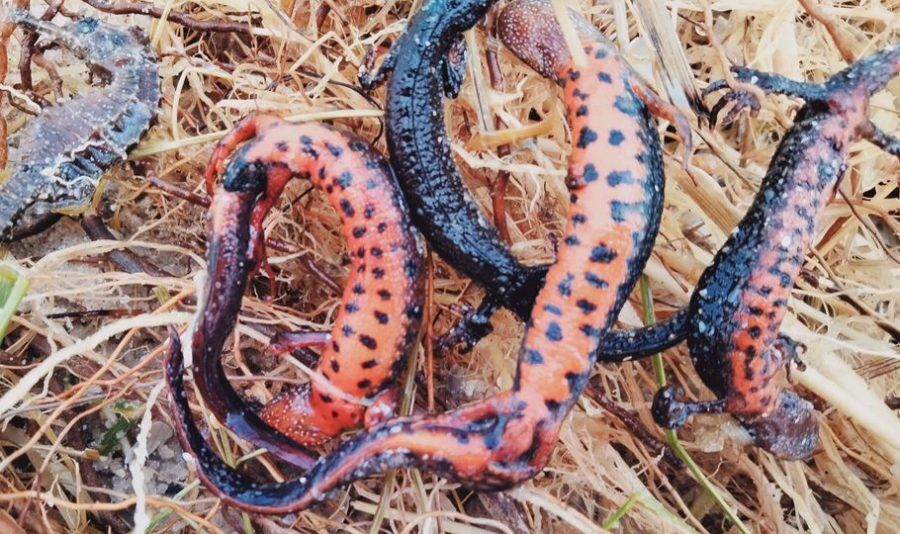
Photos by Ivan Rusev and Vlad Balinsky.
Two protected species of newts (Triturs cristatus and Triturus dobrogicus) inhabited the lower reaches of the Dnipro River. Both populations were destroyed and thrown out of their usual habitat. The animals died or became ‘internally displaced’.
In mid-July, Vladyslav Balinsky, head of the Green Leaf NGO, discovered a threatening phenomenon during a regular inspection of the Odesa Black Sea coastline: the mass death of mussels. ‘About 50% of all mussels have died in the basin of Dog Beach,’ he wrote on Facebook, ’The process is so large-scale that in some places limestone rocks have been exposed. I think the situation with mussels is similar on all Odesa beaches with breakwaters. In the colonies 100 metres behind the breakwater on the sea side, the number of dead mussels is much lower (up to 20%), but even so, within the desalinated sea area, it is hundreds and hundreds of tonnes. The general appearance of the colonies is terrible – they are covered with mucus like a film.’
The ecologist’s conclusion: ‘The ability of the sea to cleanse itself in the waters of the Gulf of Odesa and especially its coastal area is significantly undermined. Plant residue deposits are a strong pollutant as a permanent source of organic suspension and pose a threat to local offshore processes.’
In general, in just 10 days after the Kakhovka disaster, about 1 million mussels died off the coast of Odesa, which amounted to approximately 3,500 tonnes of dead mussels. These figures were made public by Galina Minicheva, Director of the Institute of Marine Biology, at the aforementioned roundtable discussion on the impact of military operations on marine ecosystems in Ukraine.
‘The consequences of this catastrophe, spreading over thousands of square kilometres, have become apparent over the past year and are likely to persist indefinitely,’ say the authors of a study of the destruction of the Kakhovka dam and its aftermath, conducted by the NGOs Truth Hounds and the Expedite Justice Project “Drowned by War”.
The authors of the report assessed all the arguments for qualifying the destruction of the Kakhovka dam as a war crime. This case may be the first application by the ICC of Article 8(2)(b)(iv) of the Rome Statute, which refers to the causing of ‘excessive’ environmental damage in comparison to the expected military advantage. In this way, international law may become more effective in punishing environmental crimes at the global level.
The material was created with the support of Journalismfund Europe


